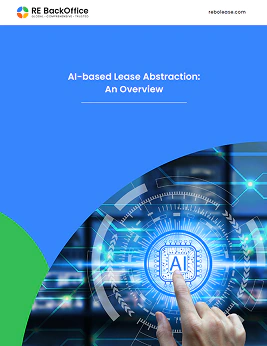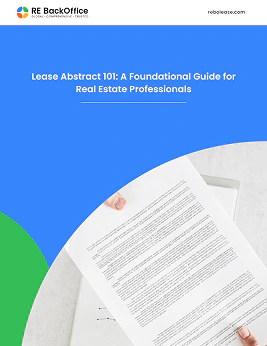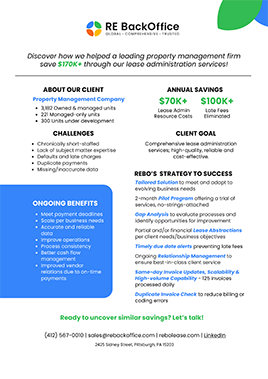
Lease administration plays a crucial role in managing real estate portfolios by ensuring compliance, optimizing costs, and improving operational efficiency. Whether handling a few leases or managing a large portfolio, effective lease administration requires a structured approach, clear documentation, and strategic use of technology.
In this guide, we'll explore the best practices for lease administration, covering key processes such as lease tracking, financial management, compliance monitoring, risk mitigation, and leveraging automation for streamlined operations.
Understanding Lease Administration
Lease administration involves the management, tracking, and enforcement of lease agreements to ensure that all financial, legal, and operational obligations are met. This includes rent payments, expense reconciliations, lease renewals, and compliance with lease terms.
A well-structured lease administration process benefits both landlords and tenants by reducing risks, preventing financial discrepancies, and maintaining regulatory compliance.
Key Responsibilities in Lease Administration
- Lease Compliance Management: Ensuring adherence to lease terms, conditions, and renewal obligations
- Rent and Financial Tracking: Managing base rent, escalations, and additional charges (e.g., CAM, taxes, insurance)
- Lease Documentation & Data Management: Storing and updating lease agreements, amendments, and key records
- Expense Reconciliation & Audits: Conducting CAM (Common Area Maintenance) and expense reconciliations to ensure accurate billing
- Risk Management & Dispute Resolution: Identifying lease risks, handling disputes, and ensuring legal compliance
- Performance Monitoring & Reporting: Tracking key lease metrics, generating reports, and supporting strategic decision-making
Effective lease administration minimizes financial risks, improves landlord-tenant relations, and enhances long-term property management efficiency.
Best Practices for Lease Administration
1. Centralizing Lease Data for Accuracy, Accessibility, and Compliance
A centralized lease database ensures that lease information is accurate, easily accessible, and secure. Storing lease documents, key dates, financial obligations, and compliance records in a single system prevents data fragmentation and improves efficiency.
Best practices for lease data centralization:
- Use cloud-based lease management systems for real-time access
- Maintain consistent data entry standards to avoid discrepancies
- Implement role-based access controls to protect sensitive lease information
By consolidating lease data, businesses can streamline decision-making, reduce administrative errors, and enhance transparency.
2. Automating Lease Tracking, Payments, and Key Date Management
Lease administration requires tracking multiple critical dates, including lease expirations, rent escalations, renewal deadlines, and compliance requirements. Missing key dates can result in financial penalties, lease disputes, or operational disruptions.
Best practices for automated lease tracking:
- Use lease management software with automated alerts for key dates
- Set up reminder systems for rent payments, CAM reconciliations, and lease renewals
- Automate late fee calculations and escalation tracking to ensure financial accuracy
Automation eliminates manual errors, enhances efficiency, and ensures timely lease management actions.
3. Ensuring Financial Accuracy, CAM Reconciliations, and Expense Audits
Financial management is a core component of lease administration. Rent payments, common area maintenance (CAM) charges, taxes, and insurance must be accurately tracked and reconciled.
Best practices for financial accuracy in lease administration:
- Conduct regular rent audits to ensure proper invoicing and collections
- Reconcile CAM expenses with tenants to maintain transparency
- Standardize expense reporting to prevent billing discrepancies
- Implement lease accounting standards (ASC 842, IFRS 16) for compliance
Proper financial tracking not only ensures revenue accuracy but also builds trust between landlords and tenants.
4. Implementing Lease Compliance Monitoring and Risk Management Strategies
Lease compliance is critical to avoid legal disputes, regulatory fines, and financial losses. Ensuring adherence to lease terms, zoning laws, and industry regulations helps mitigate potential risks.
Best practices for compliance monitoring:
- Conduct regular lease audits to verify adherence to contractual terms
- Monitor regulatory changes that impact lease agreements
- Maintain detailed compliance checklists for each lease
- Use AI-driven contract analysis tools to identify potential risks
A proactive compliance strategy helps businesses avoid costly legal disputes and enhances operational stability.
5. Optimizing Lease Renewals, Terminations, and Negotiation Strategies
Handling lease renewals and terminations effectively ensures businesses can optimize space utilization and cost savings. Poor lease negotiation or late renewals can result in increased expenses or loss of valuable leasing opportunities.
Best practices for lease renewals and negotiations:
- Start lease renewal discussions well before expiration deadlines
- Conduct market analysis to negotiate favorable lease terms
- Use lease benchmarking tools to compare market rates and conditions
- Maintain a lease termination strategy to avoid penalties and transition disruptions
Optimizing lease renewals and terminations ensures businesses make informed real estate decisions while minimizing financial risks.
6. Leveraging AI, Automation, and Technology for Lease Administration Efficiency
Technology plays a key role in modern lease administration by streamlining processes, reducing human errors, and providing data-driven insights. AI and automation tools can enhance efficiency, accuracy, and scalability.
Best practices for leveraging technology:
- Use lease management platforms (MRI, Yardi, LeaseAccelerator, etc.)
- Implement AI-based document analysis for lease abstraction and compliance monitoring
- Utilize automated reporting dashboards for financial and operational insights
- Enable cloud storage and digital workflows for seamless document management
By integrating AI and automation, businesses can reduce administrative workload and improve decision-making.
7. Strengthening Tenant and Landlord Relations Through Clear Communication
A strong relationship between tenants and landlords ensures smooth lease operations, reduces disputes, and enhances long-term partnerships.
Best practices for tenant-landlord relations:
- Maintain clear communication regarding lease obligations and policy updates
- Provide timely responses to tenant inquiries and requests
- Ensure fair and transparent billing practices for additional expenses
- Conduct regular lease performance reviews with tenants
Effective communication fosters trust, improves tenant retention, and minimizes conflicts.
8. Establishing Standard Operating Procedures for Lease Administration
Standardized procedures ensure consistency, efficiency, and compliance in lease administration. A well-documented lease administration framework reduces errors and enhances team coordination.
Best practices for lease administration SOPs:
- Create standardized lease templates to ensure consistency
- Develop step-by-step lease administration workflows for different processes
- Implement training programs to keep lease administrators up to date
- Maintain audit-ready documentation for financial and legal reviews
A structured SOP ensures seamless lease management and enhances operational reliability.
Effective lease administration is essential for ensuring compliance, financial accuracy, and operational efficiency. By implementing best practices such as centralizing lease data, automating key processes, conducting regular audits, and leveraging technology, businesses can streamline lease management, reduce risks, and improve decision-making.
A well-structured lease administration process helps organizations optimize costs, enhance landlord-tenant relationships, and ensure regulatory compliance. By staying proactive with lease tracking, renewals, and financial reconciliations, companies can prevent costly errors, improve cash flow management, and maximize real estate portfolio performance.
Investing in AI-driven tools, automation, and standardized procedures can further enhance efficiency, enabling teams to focus on strategic growth rather than manual lease administration tasks.
By following these best practices, businesses can gain better control over lease portfolios, minimize risks, and create a scalable, future-ready lease management framework.


